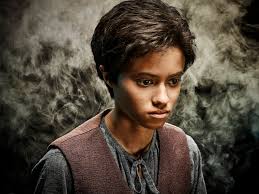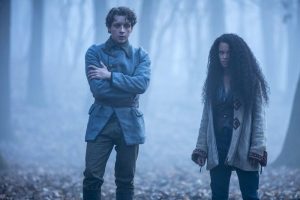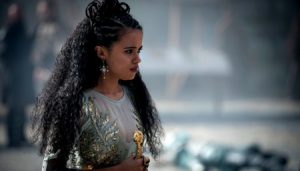I bashed NBC’s Emerald City here once with my concerns about Toto’s air-time, and in general I had problems with this gorgeous, lush story that had no center. Still, one thing Emerald City did exceptionally well, and that was the story of Tip.
I’m going to amend that statement and say that strictly in terms of plot, they did well with Eamon’s story. Eamon is the Lion. He is the only character who managed to have a complete story arc in the first season of this expensive, high-fashion fantasy. That would not mean that if there were a second season he would be gone; he is the Lion, and he needs a redemption arc… and the final scenes of Emerald City seemed to establish that.
Tip, though, is the one place where trying to subvert Frank L Baum’s original characters paid off in a meaningful way, giving us a nuanced character who represents the experiences of an under-represented group, transgendered people.
In the source material, Ozma, the princess of Oz, is stolen from her family by a witch (what a surprise!) and hidden away. The witch magically changes Ozma into a boy to avoid detection. The boy goes by Tip. When he is found, he transforms or is transformed back into a girl and becomes the ruler of Oz. Ozma appears in almost all the Oz books except the first one.
Baum wasn’t addressing gender roles; he was trying to come up with a good plot twist. Even if later Oz books are somewhat feminist, with a female ruler (and slightly socialist? Ozma insists that every subject of Oz gets what they need to live), he wasn’t drawing on any deeper theme of gender identity. Still, it’s right there, and Tarsem Singh’s reimagining of the land of Oz runs with it, in the best way.
In this story, Ozma’s parents were killed when she was an infant, but the soldier ordered to kill her as well did not. Instead, he carried her to a witch. From the time Ozma was very, very small she has been male; not disguised as a boy, but a boy, male down to her cells.
Dorothy and Lucas seek the help of an old woman who has a boy locked up in her house. She gives him medicine every night. Dorothy and Lucas, together with the boy’s friend Jack, help the boy escape. Jack and Tip run into the countryside, but they only have one more dose of Tip’s “medicine.” When the medicine wears off, Tip undergoes a transformation that baffles and horrifies him, and shocks Jack too. He turns into a woman.
This was brilliantly done, but for a moment there the story goes off the road into the underbrush. Once Jack accepts that this woman is really his friend Tip, they go off to the city of El where there might be some help. Jack makes a sexual overture to buxom Tip, who shoves him away. Jack falls off a balcony, and Tip thinks he’s dead. (Mind you, he doesn’t go to check, or call for help…) Tip flees, and the engineer Jane brings Jack back to life as a clockwork boy. The speed with which loyal friend Jack morphed into leering-frat-boy Jack –as soon as he was confronted with breasts, basically – was a disappointing and cheap way to split this duo apart so that the story could continue. After that hiccup, though, Tip’s story deepens.
As a woman… more specifically, as a young, attractive woman whose clothing somehow morphed into something that shows a lot of cleavage, Tip encounters many behaviors that baffle him. No matter how garden-variety sexist and shallowly developed this world is (and it is), these are real issues, and Jordan Loughran reacts with convincing confusion.
Even though it was heavy-handed, I laughed out loud at the scene where Gilda of the North, with her gleaming white wardrobe and her hypocritical standard of chastity for her witchling students, and West, the drug-addled madam, each try to recruit Tip. Finally Tip says, “So, as a woman, I can either be a nun or a whore?” West immediately counters, “Yes, but we get to sleep in!” This old-fashioned look at the issues of gender roles shows up throughout the show, but since this was burlesque, (and funny) it was good.
The show gets more powerful when it steers away from the outer gender roles, and lets Tip talk about how he feels, being Tip/Ozma. “I feel like this skin is the only thing of mine,” he says to West when she tries to persuade him that only in female form can he win the loyalty of an army to challenge the wizard.
West eventually becomes something of an ally to Tip, agreeing that he should try to persuade the witch army to follow him while in male form. West, who has made a living off the sexual objectification of other women, presumably, for the past twenty years in Oz, accepts Tip as who he is, and in fact chooses to relate to Tip/Ozma as the heir to the throne and the child of King Pastorius. As a viewer my interest is piqued because I wonder if West can continue to support Tip, or how long it would be before she backslides into manipulation.
Tip was born female, but he is a boy. The long-haired, busty person Tip sees in a pool of water or a mirror is not him. At the same time, the very magic of Oz itself seems to want Ozma to be female. At the end of Season One, Emerald City has not resolved Tip’s dilemma. Ozma is crowned queen of Oz, and when Tip holds the crown and gazes at the gem in the centerpiece, he sees himself, male.
Jordan Loughran deserves a shout-out for how she embodies this character. There is no safe distance in her performance between her and Tip, in either mode. She commits one hundred percent. And the mode-shifting allows for another bit of social commentary, when one of the witches scoffs at Tip’s claim that he is Ozma, saying, “That’s just a boy in a dress.”
This is much more interesting than the romance-novel conflict of Lucas, his anger management issues, or Dorothy’s obstacle-of-the-moment. It’s even more interesting than West’s self-medicating her grief and loss throughout the show. Tip’s issues are more than skin-deep, and they aren’t going to be resolved directly by magic. (Although, honestly, they could be taken care of by royal decree.) And if there were ever a Season Two, I hope the story would circle back around to the shattered friendship between Jack and Tip.



